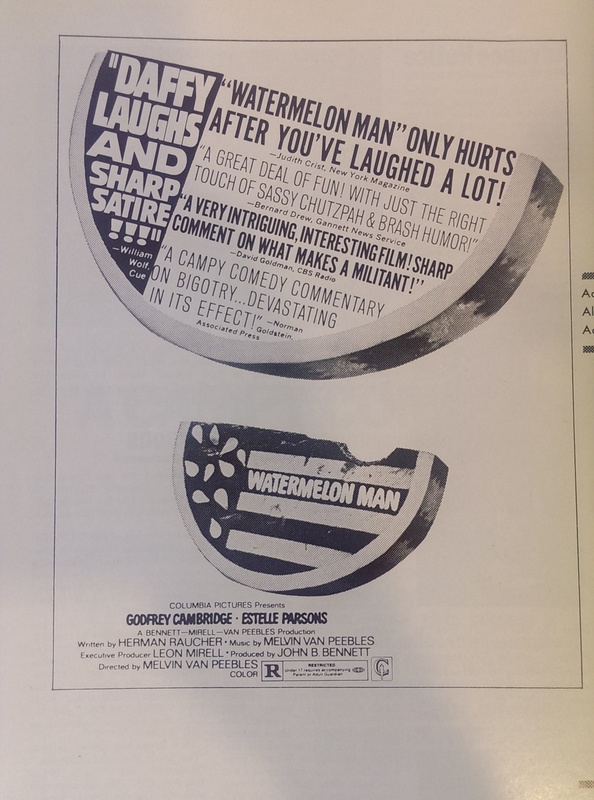Watermelon Man - Pressbook
Dublin Core
Title
Subject
Description
This page of a Watermelon Man pressbook features two images of watermelons filled with text. The one near the top of the page features critic reviews intentionally placed and colored in order to reflect the pattern of the American flag, while the bottom figure more concretely references the American flag by placing the film title on one of the flag’s stripes within the watermelon.
The first main component of the ad is the watermelon image. The watermelon symbolizes one of the many stereotypes formed against black people and the trope originates in post-Emancipation times. As freed black slaves began to work for themselves, growing watermelon as a crop, the Southern white racists’ response was to construct this fact into a degrading characterization, so as to appease their own fear of blacks’ newfound freedom (Black). The watermelon trope is historically connected to the coon caricature. The coon was characterized by its extreme appetite for watermelon, and it portrayed black people as lazy and buffoonish in nature. The film makes several references to this stereotype—mainly in the film’s title, but also in various scenes where the main character, Jeff Gerber, makes racist comments about the rioting black citizens of his town during the Civil Rights Movement. Through Gerber’s outright racist remarks, the film’s director, Melvin Van Peebles, is able to further the film’s social satire. By highlighting these stereotypes, Van Peebles also draws attention to the prevailing racism in society. Therefore, by including the image of the watermelon in the advertisement, the ad visually conveys the film’s focus on racism.
Within the figure of the watermelon is the second main component of the ad: the American flag. As the watermelon symbolically refers to the film’s commentary on racist stereotypes, the American flag symbolically connects this reference to the social satire of the film. While the bottom figure clearly illustrates the American flag pattern within the image of the watermelon, the above figure indirectly refers to this pattern, as the stripes are replaced with critic reviews, which alternate in shades in order to convey the striped pattern. The image of the American flag, especially when paired with these reviews, can be understood to represent the social critique in Watermelon Man. Each review comments on the humor in Van Peebles’s presentation, but they also acknowledge the fact that this humor is purposeful, as it mobilizes Van Peebles’s political agenda. For instance, the top right review asserts that “Watermelon Man only hurts after you’ve laughed a lot!” This statement both refers to the comedic presentation of the film’s social statement, and also points to the fact that this statement can hurt once the audience has had their laugh. Such reviews convey that there is more to Watermelon Man than just another fictional story meant for entertainment; there are parallels between the story and the current American society, and thus the social problem that Van Peebles calls attention to within the film is also symbolized in the ad’s visual representation. In this way, the critic reviews embedded within the American flag’s “stripes” strengthen the symbolism between the American flag and Watermelon Man as social satire.
Van Peebles’s choices of presentation often conflicted with Hollywood standards. With the intention presenting an explicitly anti-racist message, his unconventional route of producing such a film was, at times, obstructed by Hollywood’s goal of attracting the largest possible audience. Utilizing whiteface and playing off of racist stereotypes both mobilized Van Peebles’s message and appealed to audiences. As Racquel Gates notes in her article, “Subverting Hollywood from the Inside Out,” Van Peebles’s presentation “satirizes Hollywood’s usual methods of storytelling, demonstrating how they mask social and political inequalities” (9-11). Gates reveals yet another connection between the ad’s choice of imagery and Watermelon Man’s message: The odd combination of the watermelon and American flag in one figure reflects Van Peebles’s unconventional, and somewhat easy to miss, methods of creating social satire.Though audiences may not readily recognize the social commentary that the film makes, each image on this pressbook page, as well as the figure as a whole, visually convey Van Peebles’s claim that racism is still a problem in society. By tying the image of the watermelon and the American flag together, this promotional material helps to point viewers toward the statement that Watermelon Man makes. Thus the tools and motifs within the film and the images in the advertisement allow Van Peebles to mobilize his anti-racist message within the limits of Hollywood production.
Black, William. "How Watermelons Became a Racist Trope." The Atlantic. The Atlantic Monthly Group, n.d. Web. 3 May 2015. <http://www.theatlantic.com/national/archive/2014/12/how-watermelons-became-a-racist-trope/383529/>.
Gates, Racquel “SUBVERTING HOLLYWOOD FROM THE INSIDE OUT: MELVIN VAN PEEBLES'S WATERMELON MAN” Film Quarterly, Vol. 68, No. 1 (Fall 2014), pp. 9-21.
Citation
Catalog Search
Search for related records in these catalogs:
